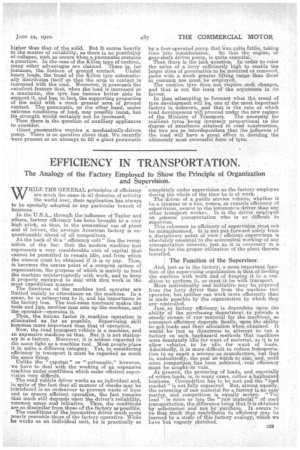EFFICIENCY IN TRANSPORTATION. ,
Page 15

If you've noticed an error in this article please click here to report it so we can fix it.
The Analogy of the Factory Employed to Show the Principle of Organization and Supervision.
WHILE THE GENERAL principles of efficiency are much the same in all domains of activity the world over, their application has always to be specially adapted to any particular branch of business.
In the 17.S.A., through the influence of Taylor and others, factory efficiency has been brought to a very high pitch, so that, in the economical use of plant and of labour, the average American factory is unquestionably ahead of all competitors.
At the back of this " efficiensy cult" lies the recognition of the fact that the modern machine tool represents a very considerable unit of capital that cannot be permitted to remain idle, and from which the utmost must be obtained if it is to. pay. Thus, it becomes the centre point of a, complex system of organization, the purpose of which is mainly to feed the machine uninterruptedly with work, and to. keep it properly equipped to deal with that work in the most expeditious manner. The functions of the machine tool operator are limited mainly to attendance on the. machine. In a sense, he is subservient to it, and hus. importance in the factory less. The tool-room mechanic makes the tools and jigs, another man sets up the machine, and the operator—operates it.
Thus, the 'human factor in machineoperation is eliminated as far as possible. Supervising skill becomes more important than that of operation. Now, the road transport vehicle is a machine, and en expensive machine at that. But it is not stationsry in a factory. Moreover, it is seldom regarded in the same light as a machine tool. Most people place it in quite a different category. Yet, in considering efficiency in transport it must be regarded as much the same thing.
Unlike the capstan " or " automatic," however, we have to deal with the working of an expensive machine under conditions which make efficient supervision very difficult.
The road vehicle driver works as an individual and, in spite of the fact that all manner of cheeks may be introduced is an endeavour to prevent waste of time and to ensure efficient operation, the fact remains that much still depends upon the driver's reliability, common sense and initiative. Thus, the conditions are as dissimilar from those of the factory as possible.
The conditions of the locomotive driver much more nearly resemble those of the factory operative. While he works as an individual unit, he is practically as
completely under supervision as the factory employee during the whole of the time be is at work. . The driver of a public eerviee vehicle, whether it he a tramcar or a bus, comes, as regards efficiency of supervision, nearer to the locomotive driver than any other transport worker,. It is the driver employed on general transportation who is so difficult to supervise. This reference to efficiency of supervision must not be misunderstood. It is not put forward solely from a disciplinary point of view ; efficient, eupervision is absolutely essential to the economical war:king of any transportation concern, 3ust as it is necessary in a factory for the pro-per utilization of the plant therein installed.
The Function of the Supervisor.
And, just as in. the factory, a moat important function of the supervising organization is that of feeding the machine with work and of keeping it in a. condition to perform it, so must, it be with transport. More, individuality and initiative may be required . from the lorry driver than from the machine tool operator, but neither can work more efficiently than is made possible by the organization by which they arecontrolled.
Just as factory efficiency is. dependent upon the ability'. of the purchasing :department to provide a steady stream of raw-material for the machines, so transport. efficiency depends finally, upon the ability to get loads-and their allocation when obtained. It would 'be just as disastrous to attempt to run a factory on such haphazard methods that machines were constantly idle. for want of material, as it is to allow vehicles to be idle for want of loads. Admittedly, it is mere-difficult to reduce tainsportation to as exact a science as manufacture, but that is, undoubtedly, the goal at which•to aim, and, until some Comparison has been achieved; real efficiency must be soughtin vain. At Present, the procuring of loads, and especially of return loads, is, in many cases, rather a haphazard business. Competition has to be met and the "load market" is not fully organized But, almost equally, the procuring of raw material for a factory is no easy matter, and competition is equally severe. "The. load " is more or less the "raw material" of -road transportation, the difference being that it is obtained :by solicitation and not by purchase. It occurs to usthat much -that contributes to efficiency may be learned by a study of this factory analogy, which we have but vaguely sketched.




































